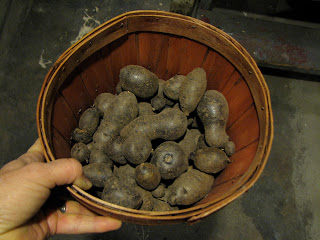The forecast calls for some pretty frigid temperatures in the coming week so I decided that I'd bring in the last of the potatoes. It's not just about harvesting, it's more of an assessment of my potato plan. What worked and didn't? More importantly, was it worth it?
This past Spring, I planted my seed potatoes in containers. My garden is a tiered one, to accommodate the slope in our yard. Turning up potatoes would definitely undermine the stability of the retaining walls.
So I tried planting in containers. Considering the fact that I planted them rather late in the Spring and that the area doesn't get a ton of sun, I'd say my plan was a moderate success.
I tried a couple of varieties in larger garbage cans. The first can that I emptied didn't contain one potato, despite the fact that the vines grew just as vigorously as the others. I wasn't sure if it was the variety ("Yukon Golds") or the can. The soil in that container was markedly wetter than the others. The other can that I planted contained a variety that did very well in the smaller container, but its performance in the garbage can was pretty disappointing. I may try with the larger containers again next year, but I'll be sure to add more drainage holes. I think the soil in the larger cans just got too wet and the majority of the potatoes planted in them rotted.
Harvesting the potatoes in the containers was a snap. I dumped the wash bin into the wheelbarrow and fished out the potatoes. They were ready to go to the basement to be cured! The soil went into a pile by the compost bin to fill next year's containers.
 |
| It's a modest harvest, but encouraging. |
Click here to read my earlier post on planting potatoes in containers.
Click here to learn about saving potatoes for planting next season.
Click here to learn about curing potatoes for storage.













